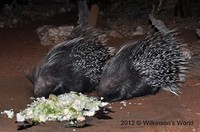Facts about Porcupine

Contrary to popular belief, porcupines are not capable of throwing their quills, but they detach very easily and will remain embedded in an attacker.

The two families of porcupines are quite different, and although both belong to the Hystricognathi branch of the vast order Rodentia, they are not closely related.

The European porcupine (Hystrix cristata) is the typical representative of a family of Old World rodents, the Hystricidae, all the members of which have the same protective covering.

Most porcupines are about 25-36 inches (60-90 centimeters) long, with a 8-10 inch (20-25 centimeter) long tail.

The tree porcupines (Coendou, Sphiggurus, and Echinoprocta) contain 14 or 15 species, depending on the taxonomic scheme.

Rothschild's porcupine of South America weighs less than a kilogram; the African porcupine can grow to well over 20 kilograms.

The porcupines are represented in the Old World by the members of the family Hystricidae.

A porcupine is any of 28 or so species of rodent belonging to the families Erethizontidae or Hystricidae.

The genus Atherurus includes the brush-tailed porcupines, which are much smaller animals, with long tails tipped with bundles of flattened spines.

The fisher (a North American marten) is particularly adapt at eating porcupines.

The New World porcupines evolved their spines independently (through convergent evolution) and are more closely related to several other families of rodent than they are to the Old World porcupines.

The name "porcupine" comes from Middle French porc d'йpine "thorny pork", hence the nickname "quill pig" for the animal.

Porcupines are attracted to roads in areas where rock salt is used to melt ice and snow, and are known to gnaw on vehicle tires or wiring coated in road salt.

Porcupine is the common name for any members of two families of rodents, Erethizontidae and Hystricidae, characterized by heavy bodies with some areas covered with long, sharp quills or spines (modified hairs).

Members of Erethizontidae are known as the New World porcupines and members of Hystricidae are known as the Old World porcupines.

Porcupines are all stout animals, with blunt rounded heads, fleshy mobile snouts, and coats of the thick cylindrical or flattened spines ("quills").

Porcupines occupy a wide range of habitats in tropical and temperate parts of Asia, Italy, Africa and North and South America.

The 12 Old World porcupines are almost exclusively terrestrial, tend to be fairly large, and have quills that are grouped in clusters.

The porcupines are the third largest rodent, after the capybara, and beaver, but the species vary in size considerably.

Porcupine meat is also appreciated in some regions of Italy and Vietnam.



